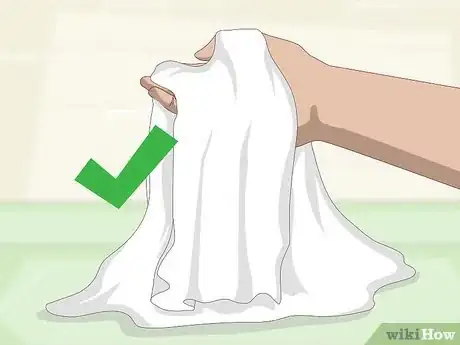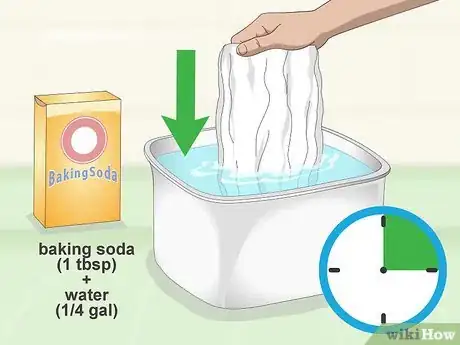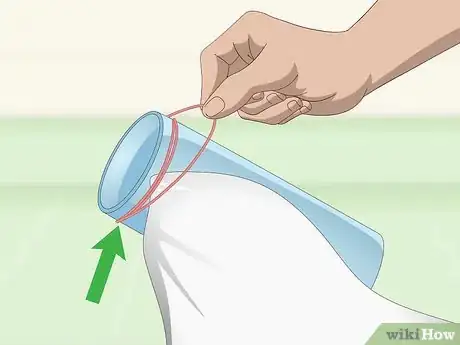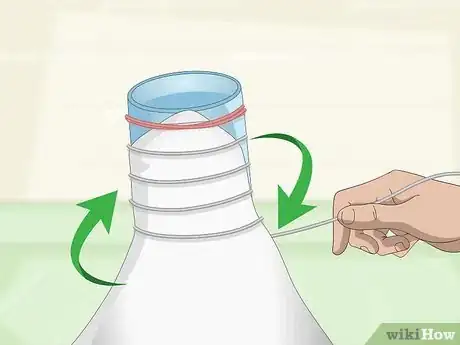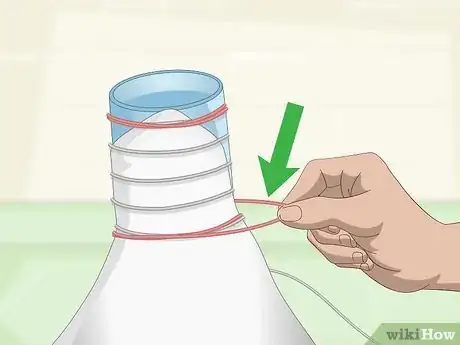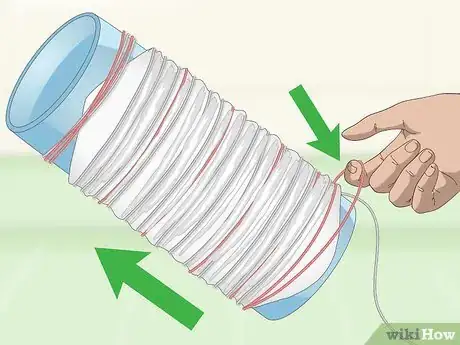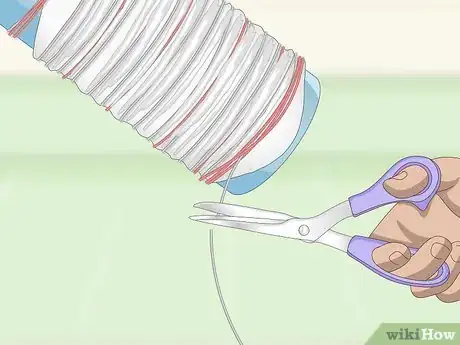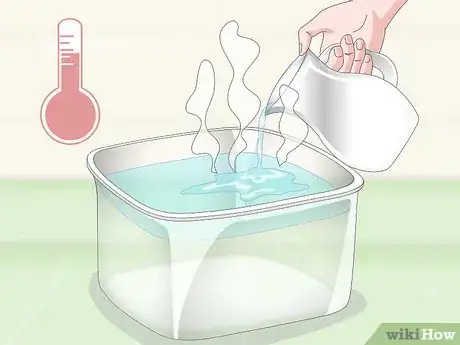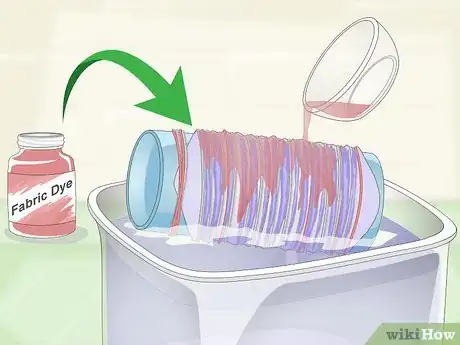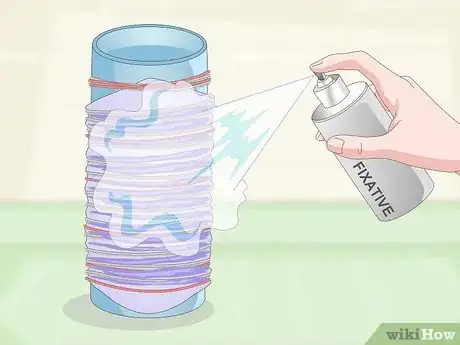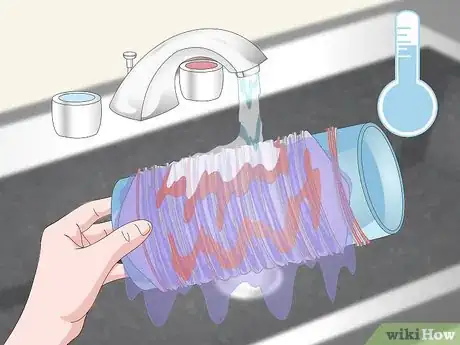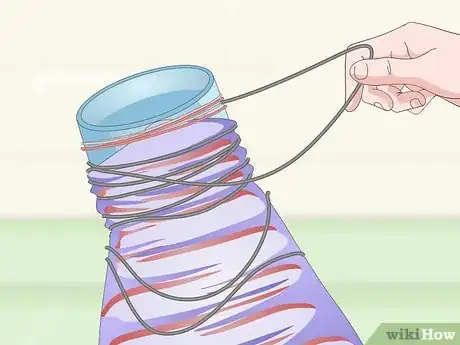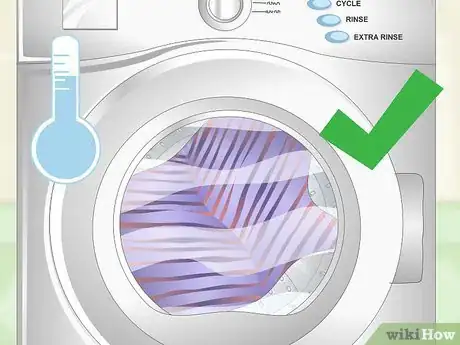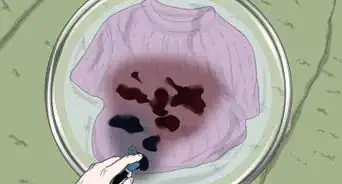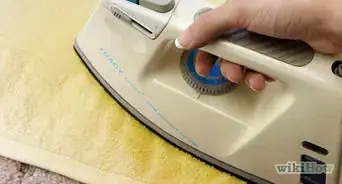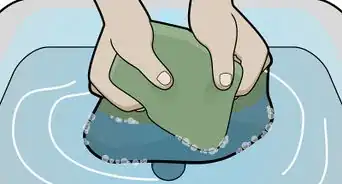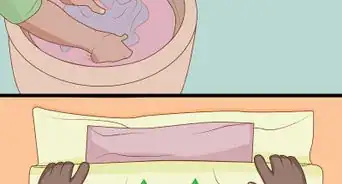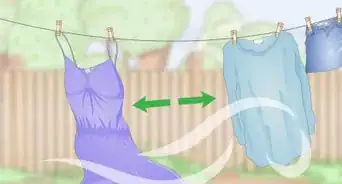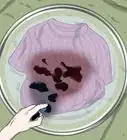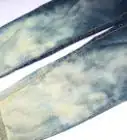This article was co-authored by wikiHow staff writer, Kyle Hall. Kyle Hall works on the content team at wikiHow. He helps manage our team of editors and creates content for a variety of wikiHow projects. Kyle continually looks for new ways to improve the content at wikiHow and make it more helpful and enjoyable for readers. He graduated from Eckerd College in 2015, where he majored in Political Science.
There are 16 references cited in this article, which can be found at the bottom of the page.
This article has been viewed 29,993 times.
Learn more...
Arashi Shibori is a traditional Japanese technique used to dye fabrics. To dye fabric using this technique, you’ll need a cylindrical object and some twine or yarn to tie the fabric down with. You can dye your fabric any color you’d like, and you can even mix and match different colors. As you get better, you can start experimenting with different ways of wrapping the fabric to get more intricate designs.
Steps
Prepping the Fabric
-
1Choose a fabric made of all natural fibers. You can dye things like blankets, sheets, pillowcases, shirts, and dresses. Cotton, wool, silk, and polyester are all natural fibers you can use.[1]
- Start with a smaller item, like a shirt, bandana, or scarf, if it’s your first time dyeing with the arashi shibori technique.
-
2Presoak the fabric in a baking soda bath for 15 minutes. Mix ¼ gallon (.95 liters) of water and 1 tablespoon (14.8 mL) of baking soda in a large bowl or plastic container. Submerge the fabric in the baking soda bath. The baking soda bath will help the fabric absorb more color when you dye it.[2]
- If you're dyeing a large piece of fabric, double the amount of water and baking soda you use.
Advertisement -
3Fold the fabric into a rectangle. Folding your fabric in a rectangular shape will make it easier to tie onto the pole for dyeing. If the fabric you’re dyeing is already square or rectangular, you can leave it as is or fold it in half once if it’s big.
- For example, if you’re dyeing a t-shirt, you would want to fold the sleeves in and then fold the shirt in half lengthwise.
-
4Attach a corner of the fabric to a cylindrical object using a rubber band. Traditional arashi shibori is done using a long wooden pole, but you can use any object that is cylindrical in shape.[3] A PVC pipe, large mason jar, or card stock tube will work. Place a corner of the fabric flat on the cylinder so it's touching one of the ends of the object.[4]
- Wrap a rubber band around the end of the cylinder and over the corner of the fabric so it’s held in place.
Tying Down the Fabric
-
1Attach the end of a piece of twine to the rubber band. If you don’t have twine, use yarn or a thick thread instead. Loop the end of the twine through the rubber band on the cylinder. Tie a knot so the twine is secure.[5]
-
2Wrap the twine around the cylinder and fabric. You want the twine to press the fabric flat against the surface of the cylinder. Keep wrapping the twine around, leaving about 1 inch (2.5 cm) between each loop you make.
-
3Add another rubber band after making four loops around the fabric. The second rubber band will help hold the fabric and twine in place. Slide the rubber band over the cylinder and fabric and position it right next to the last loop of twine you made.[6]
-
4Scrunch up the fabric to make more room on the cylinder. Push the fabric up toward the end of the cylinder you started at. Each loop of twine you wrapped should be pushed up to the one that came before it so they’re nearly touching. The second rubber band you put on the cylinder should now be about ½ inch (1.3 cm) away from the first rubber band you put on.[7]
- You want the fabric to be bunched up between the loops of twine. The bunching up of the fabric is what will create the unique design when you dye it.
-
5Continue wrapping and scrunching the fabric until it’s all on the cylinder. After every few loops of twine you make, add another rubber band and scrunch up the fabric. When you’re finished, all of the fabric should be tightly bunched up on the cylinder.[8]
-
6Use scissors to cut the twine from the rest of the ball. Loop the loose end of the twine through one of the rubber bands on the cylinder.
Adding the Dye
-
1Fill a large plastic container with near-boiling water. Use a container large enough to hold the cylinder you’re dyeing the fabric on. Fill it with enough water that the entire cylinder can be submerged.[9]
-
2Add fabric dye to the water. You can find fabric dye in a color of your choice at your local craft store. Shake the bottle of dye before you open it. Read the instructions on the back of the dye to see how much dye you should use. The more dye you use, the more saturated the color will be. Thoroughly stir the mixture with a spoon.[10]
- Wear rubber gloves when you pour the dye in so you don’t get any on you!
- If you’re dyeing cotton or linen, add 1-2 cups (236-472 mL) of regular table salt to the water to help the dye attach to the fabric.[11]
-
3Soak the cylinder and fabric in the dye bath for 10 minutes. Completely submerge the cylinder. If there’s not enough water in the dye bath to cover all of the fabric, add more. If you want the color on the fabric to be more saturated, leave it in the dye bath for longer than 10 minutes.[12]
-
4Add different colors to your fabric if desired. Mix a different color dye with water in a small dish. Lift the fabric out of the dye bath and pour some of the new dye onto the fabric. Set the fabric back in the dye bath for 10 minutes.[13]
- For a more precise design, use an eyedropper to apply the new dye.
-
5Spray the fabric with a fixative to preserve the dye. Do this before you take the fabric off the cylinder. You can find a dye fixative at your local craft store.[14]
Finishing Up
-
1Rinse the cylinder and fabric under cold water. Rotate the cylinder in your hands so all the fabric is getting rinsed. Continue rinsing until the water coming off the fabric runs clear.[15]
-
2Unwrap the twine around the fabric. Pull off the rubber bands as well. Once the fabric is completely off the cylinder, set the cylinder aside.
-
3Unfold the fabric and rinse it thoroughly under cold water. Continue rinsing the fabric until the water coming off it runs clear. Wring out the fabric once you’re finished rinsing.[16]
-
4Machine wash the fabric in cold water. Wash it on the coldest setting and then dry regularly. You can also air-dry the fabric if you're worried about it shrinking. Once the fabric is done drying, it’s ready to be worn or displayed!
- For future washes, wash the fabric separately to avoid dye transferring to your other fabrics.
Things You’ll Need
- Fabric made of all natural fibers
- Cylindrical object
- Rubber bands
- Twine
- Plastic container
- Fabric dye
- Dye fixative
References
- ↑ https://www.youtube.com/watch?v=f4CsBV_tnf0&feature=youtu.be&t=55
- ↑ https://www.youtube.com/watch?v=T6Z5OQV3D-Y&feature=youtu.be&t=48
- ↑ https://shibori.org/traditions/techniques/
- ↑ https://www.youtube.com/watch?v=f4CsBV_tnf0&feature=youtu.be&t=58
- ↑ https://www.youtube.com/watch?v=f4CsBV_tnf0&feature=youtu.be&t=65
- ↑ https://www.youtube.com/watch?v=f4CsBV_tnf0&feature=youtu.be&t=74
- ↑ https://www.youtube.com/watch?v=f4CsBV_tnf0&feature=youtu.be&t=85
- ↑ https://www.youtube.com/watch?v=f4CsBV_tnf0&feature=youtu.be&t=117
- ↑ https://www.youtube.com/watch?v=f4CsBV_tnf0&feature=youtu.be&t=157
- ↑ https://www.youtube.com/watch?v=f4CsBV_tnf0&feature=youtu.be&t=165
- ↑ https://www.youtube.com/watch?v=f4CsBV_tnf0&feature=youtu.be&t=168
- ↑ https://www.youtube.com/watch?v=f4CsBV_tnf0&feature=youtu.be&t=193
- ↑ https://www.youtube.com/watch?v=f4CsBV_tnf0&feature=youtu.be&t=243
- ↑ https://www.youtube.com/watch?v=f4CsBV_tnf0&feature=youtu.be&t=253
- ↑ https://www.youtube.com/watch?v=f4CsBV_tnf0&feature=youtu.be&t=271
- ↑ https://www.youtube.com/watch?v=f4CsBV_tnf0&feature=youtu.be&t=276
